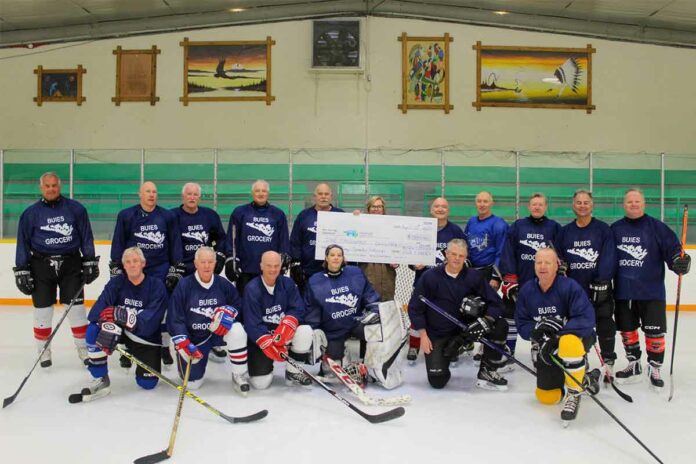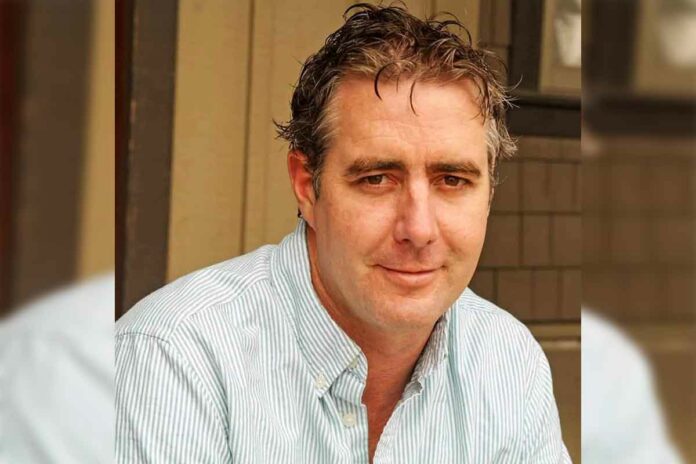WAWA—As his family suspected, former National Hockey League (NHL) player Chris Simon was suffering severe stage 3 chronic traumatic encephalopathy (CTE, caused by repeated concussions) when he died at the age of 52, as a result of suicide in 2024. This was according to a post-mortem brain tissue analysis released by his family and the Concussion Legacy Foundation (CLF) on Monday, April 14.
“Chris was suffering tremendously from CTE. We saw him declining but did not know where to turn to for help,” Mr. Simon’s parents and sister said in a statement to The Expositor. “Chris’ short-term memory issues were ongoing for many years. We also learned that he had lost most of his hearing, had daily headaches, light sensitivity, paranoia, lack of feeling and emotion, impulsivity, distancing himself from those who meant the most to him, had executive dysfunction—meaning he couldn’t plan or problem solve—and he had suicidal thoughts at times.”
According to his family, Mr. Simon had “distanced himself from his family and friends the last three years of his life.” They said the CTE diagnosis will help bring his loved ones some closure.
| Read our related story: |
| • Former NHL enforcer Chris Simon dead at 52, family suspects CTE (2024) |
“The Chris we knew had been gone for quite some time. Looking back, we now realize that Chris likely started suffering from CTE in his late 20s to early 30s,” the family said. “Our entire family suffered for many years as we saw our son, brother, father (of four), husband slip away from us, and we couldn’t do anything to help him.”
“Mr. Simon had severe CTE pathology in areas of the brain involved with cognition and mood regulation, and it is likely CTE contributed to his memory problems, depression and apathy,” Dr. Ann McKee, chief of neuropathology for the VA Boston Healthcare System, said in the analysis announcement.
A gritty left winger, Mr. Simon was involved in more than 100 fights in his 15-year professional hockey career and accumulated 1,824 penalty minutes as a professional.
Immediately following his death in 2024, Mr. Simon’s family attributed his suicide to CTE. While it is not possible to diagnose individuals with the neurodegenerative condition while they are alive, symptoms such as emotional volatility and memory loss can help doctors identify potential cases, The Athletic reported.
Glen Hare of M’Chigeeng, executive director of the Ojibway Cultural Foundation (OCF) and former Anishinabek Nation Grand Council Chief, Ontario Regional Chief, and Chief of the M’Chigeeng First Nation, is a close friend of the family and he and Pat Madahbee of Aundeck Omni Kaning attended Mr. Simon’s funeral, carrying the Eagle Staff.
“We went up there for the funeral in Wawa,” Mr. Hare told The Expositor. “There was a huge gathering and Chris was given an awesome sendoff. You could feel the love everyone had for him, it was very obvious. He was a very nice guy.”
“Very sadly, and very unfortunately, from many years back, the hockey world has had players suffering head and brain injuries,” said Mr. Hare.
“I really believe that Chris and other players who were suffering (from CTE) were trying to say something about what they were going through, but were never taken seriously,” said Mr. Hare. “Hockey is a money-making business, and I’m sure he and many other players before him were asking for help but were never heard. And when he left the NHL, no one from the NHL called him, his grandfather told me. Not one. But when he died the calls poured in asking how they could help, which was too late.”
“I really hope the NHL finally looks into all the cases of players who suffered head/brain injuries and carries out an investigation,” said Mr. Hare. “Fighting still takes place in hockey and players still hit their heads on the ice and suffer concussions. I think the NHL has to ramp up safety.”
“On the day of the funeral we felt it, the respect and love everyone had for Chris,” said Mr. Hare. “I know the family well and am still close with them. When I was the chief in M’Chigeeng Chris was there three or four times to put on hockey skills training camps for kids here, and in other first nations. He was loved everywhere, especially in his hometown of Wiikwemkoong.”
“I didn’t know Chris real well, but I know the family well. I know everyone liked him,” Mr. Madahbee, Anishinabek Nation Commissioner of Governance told The Expositor. “Unfortunately, these type of head/brain injuries are prevalent in a lot of sports. It shows up in a lot of football players, but the National Football League and other professional leagues have taken steps to improve safety for the players, but this isn’t the case with hockey.”
“One of the problems with all sports and is something I can relate to from my (hockey) playing days is that professional players especially, are supposed to act macho, and shrug off injuries, or coaches get them to play through injuries. If a player gets hurt, team doctors are to freeze the area that is hurting, and the player is expected to continue to play. It is a common thing,” said Mr. Madahbee.
“Because of all the awareness these days of CTE and the effects of concussions, maybe these things will improve,” said Mr. Madahbee.
“It is a sad situation that guys like Chris, Stan Jonathan, Ted Nolan, Denny Lambert and many others were prolific scorers and good all-round athletes, who are turned into enforcers by their coaches,” continued Mr. Madahbee, who played hockey with Chris’ father John and when he was a young man, Maxie Simon.
During his NHL career, Chris Simon scored 161 goals and added 168 assists. He competed in 75 playoff games, including The Colorado Avalanche during their first Stanley Cup run in 1996, and returned to the Stanley Cup finals with the Washington Capitals in 1998 and the Calgary Flames in 2004.
A player known for delivering hard hits and often initiating altercations, the NHL suspended Mr. Simon eight times over his career. He missed a total of 65 games due to suspensions, including a 30-game suspension in 2007 that ranks among the longest in league history, The Athletic reported. Mr. Simon filed for bankruptcy in 2017 and could not work due to CTE and other injuries he sustained during his playing career. He began collecting disability payments earlier that year and joined a class-action lawsuit over the NHL’s handling of head trauma. The lawsuit was settled in 2018, although it is unclear how much of that money Mr. Simon received.
In their statement announcing his CTE diagnosis, Mr. Simon’s family lamented, “the negligence of a professional league turning a blind eye to CTE and other significant brain injuries sustained in the sport of hockey.”
The CLF explained in the report that 19 of 20 former NHL players brains studied at Boston University’s CTE Centre, including Mr. Simon, have tested positive for CTE. It noted the diagnoses of former players Bobby Hull, Ralph Backstrom, Stan Mikita, Bob Probert and Derek Boogard were included in a 2024 study by the university that “found the odds of developing CTE increased by 34 (percent) for each year of hockey played.” Mr. Simon took his own life at the age of 52 on Monday, March 18, in his hometown of Wawa.
“The family of the late Chris Simon would like to thank everyone for their overwhelming support during our incredible loss. We appreciated all the visits, hugs, food deliveries, kind words, shared tears, cards, gifts, donations in his memory and love for Chris. Thanks to everyone who travelled from afar to lay tobacco at his sacred fire and those who attended/watched his celebration with our family.”
“Special thanks to Dr. Ann McKee, Lisa McHale, Sophia Nosek and their entire team at Boston University CTE department for their outstanding work in getting us the definitive scientific proof postmortem that Chris suffered immensely from stage three of CTE as suspected by his family,” said Charlee Simon.
“Chris was a very kind and gentle soul,” Charlee Simon continued. “Chris’ children and family were his heart and soul. The family heard many beautiful stories of Chris and are requesting that these stories be sent to his sister, Charlee Simon at P.O. Box 23, Wawa, Ontario, P.O. Box 23, POS IKO as they will be given to his children and family to read during tougher days and to be shared with his future grandchildren.”





